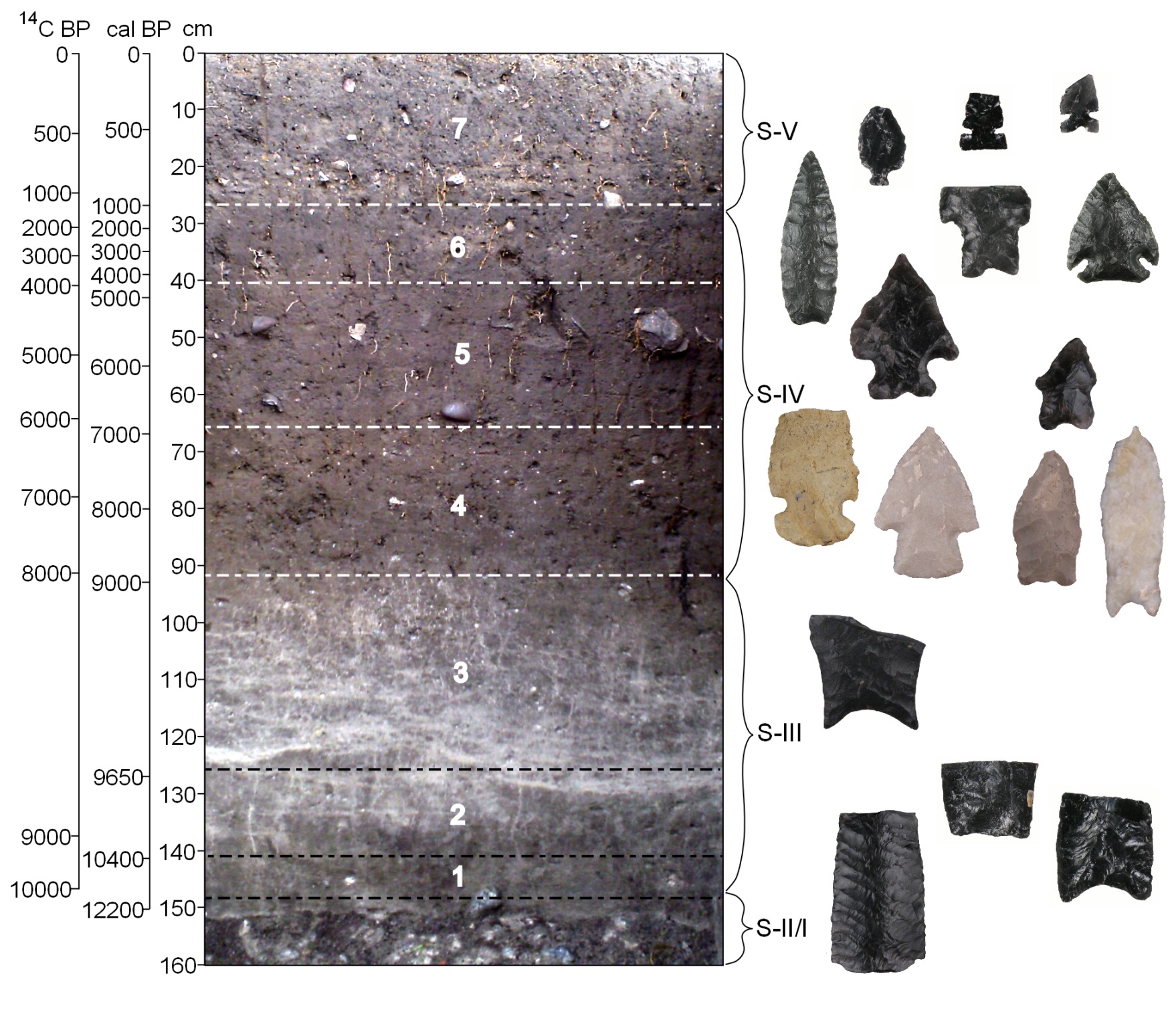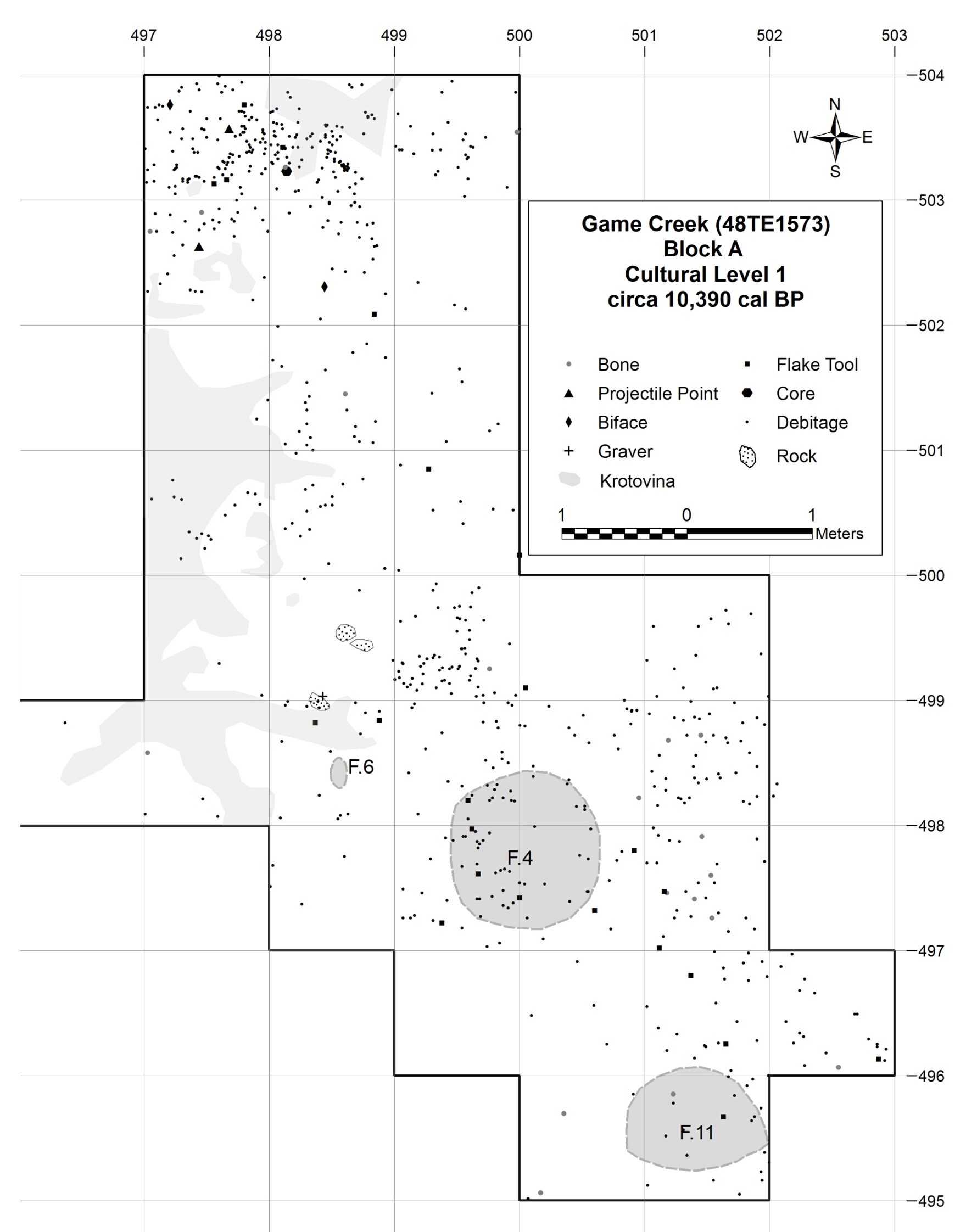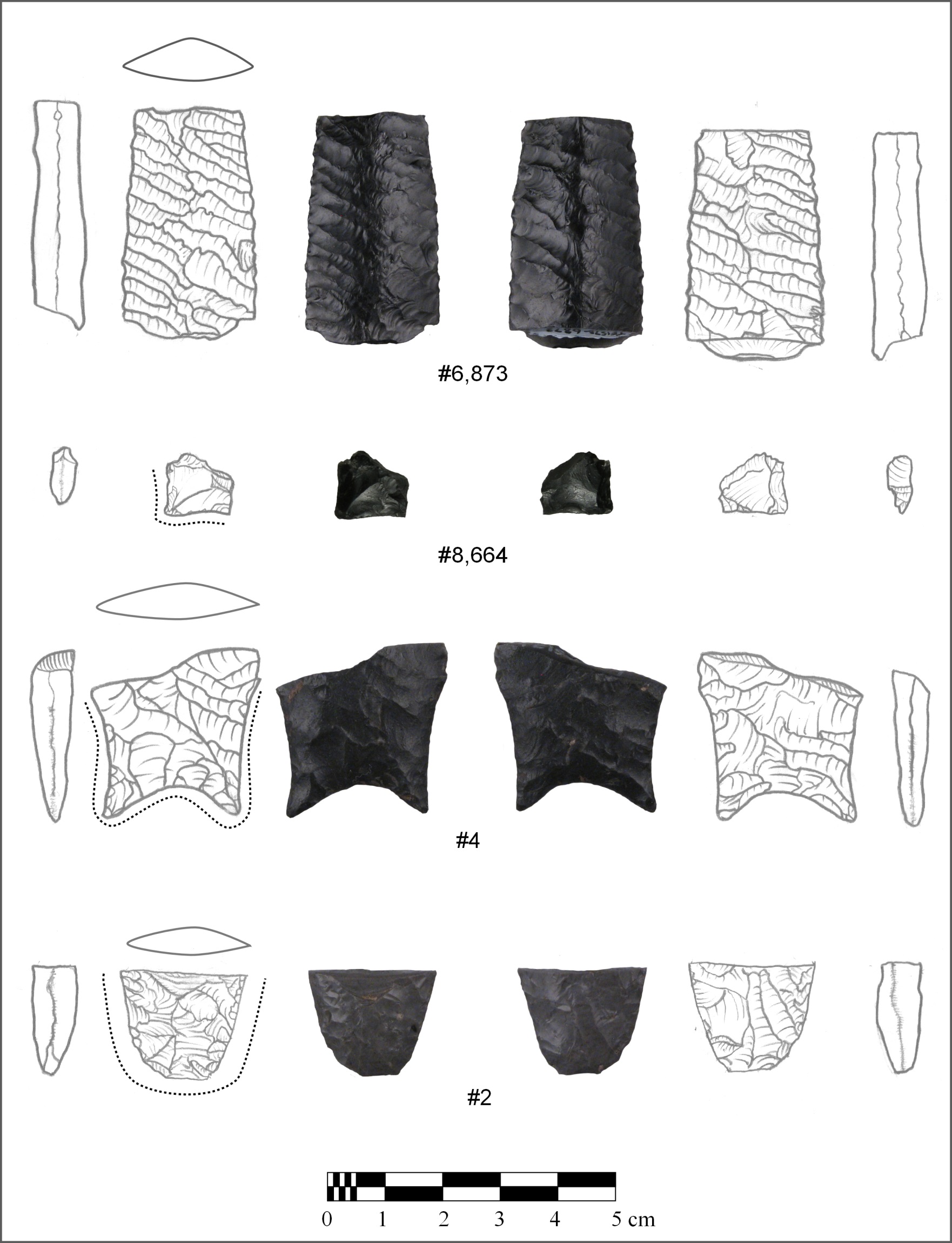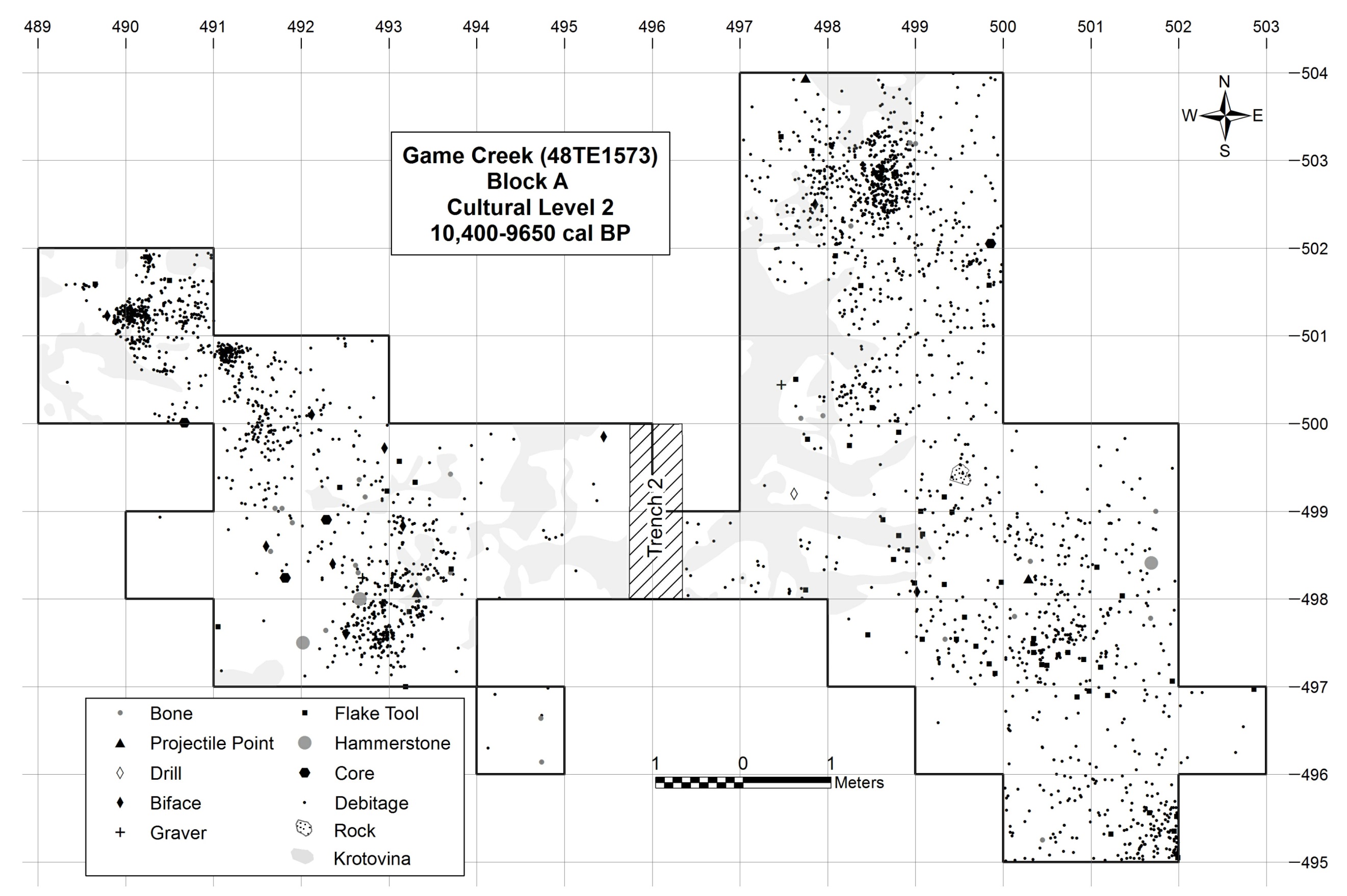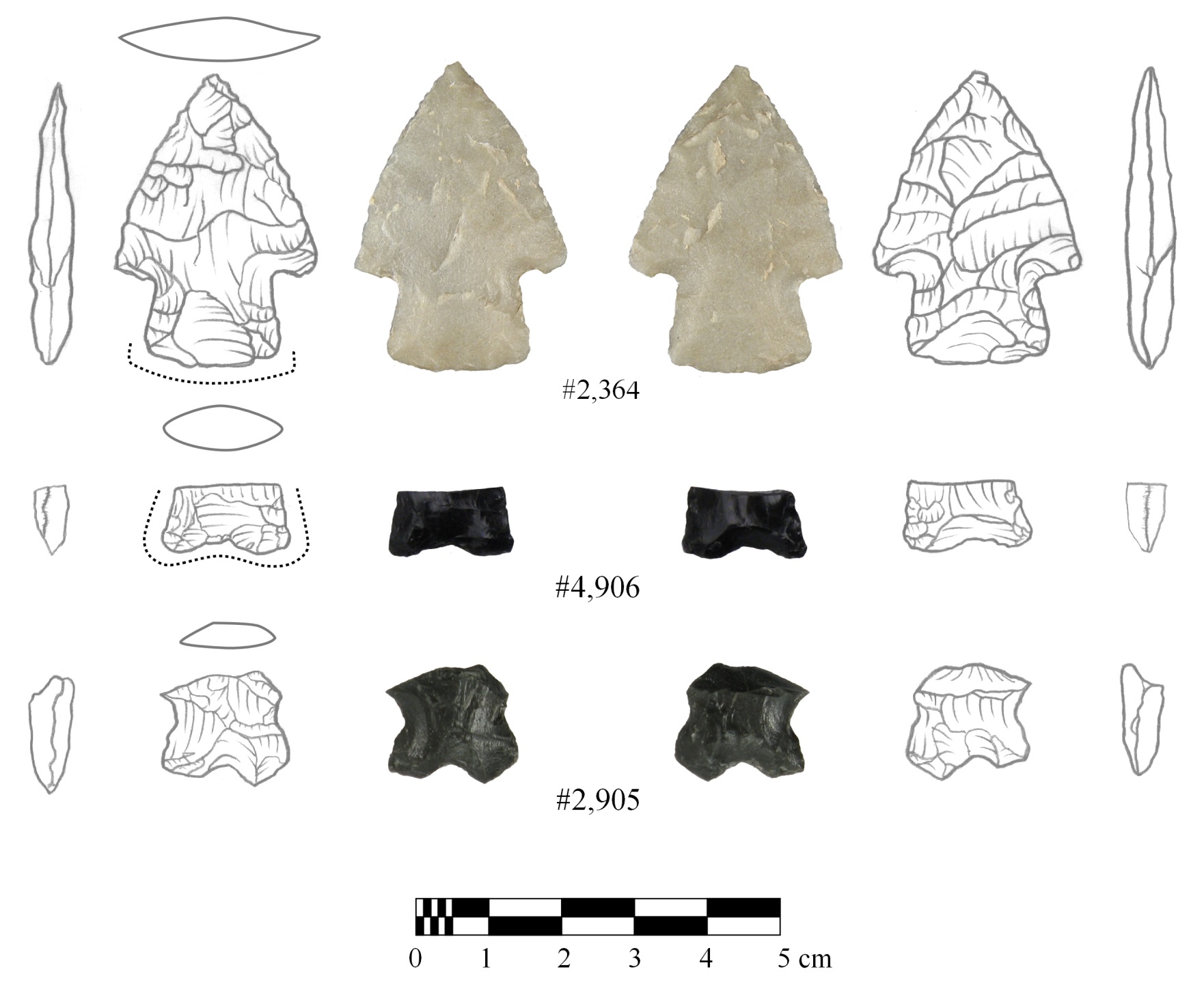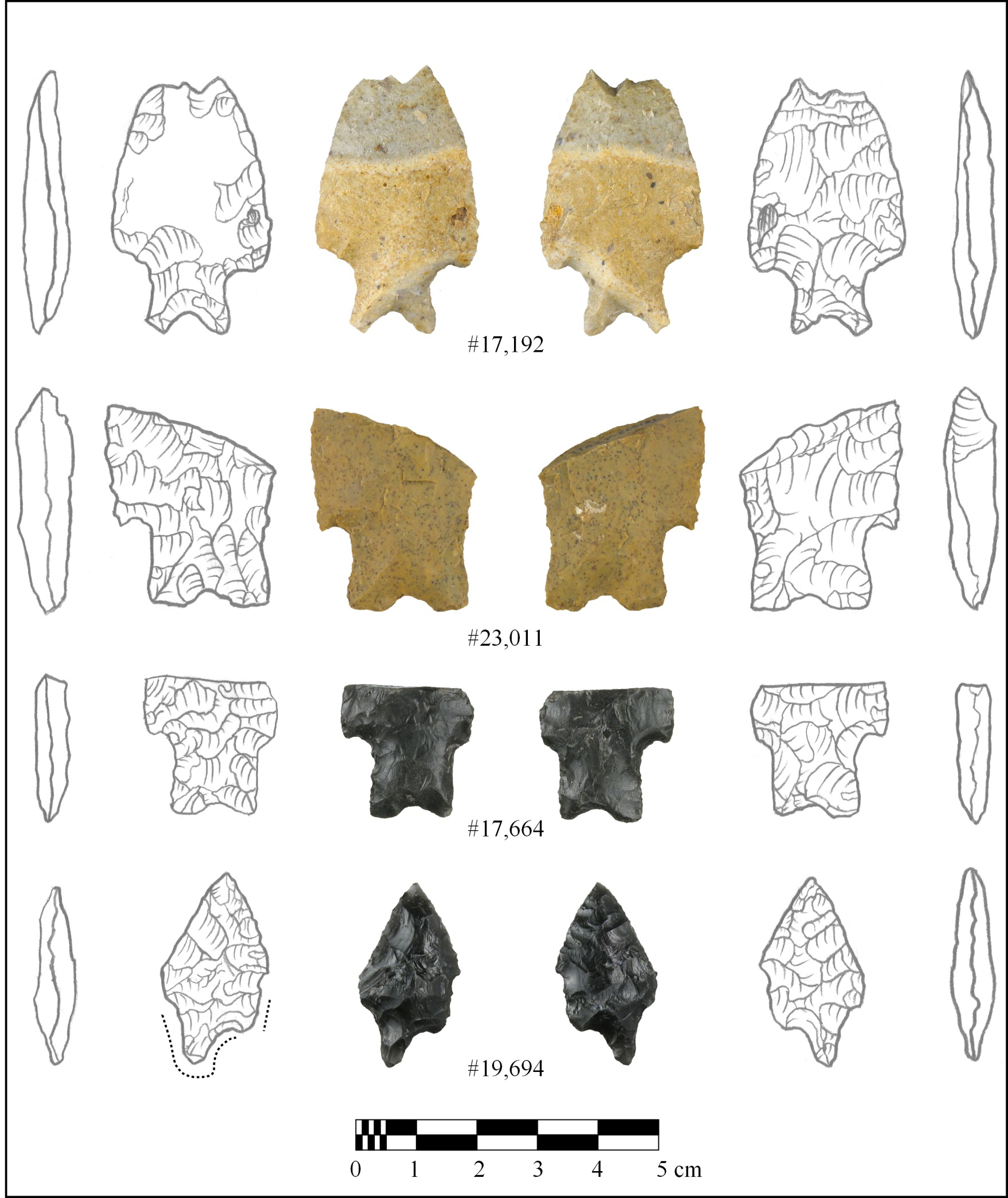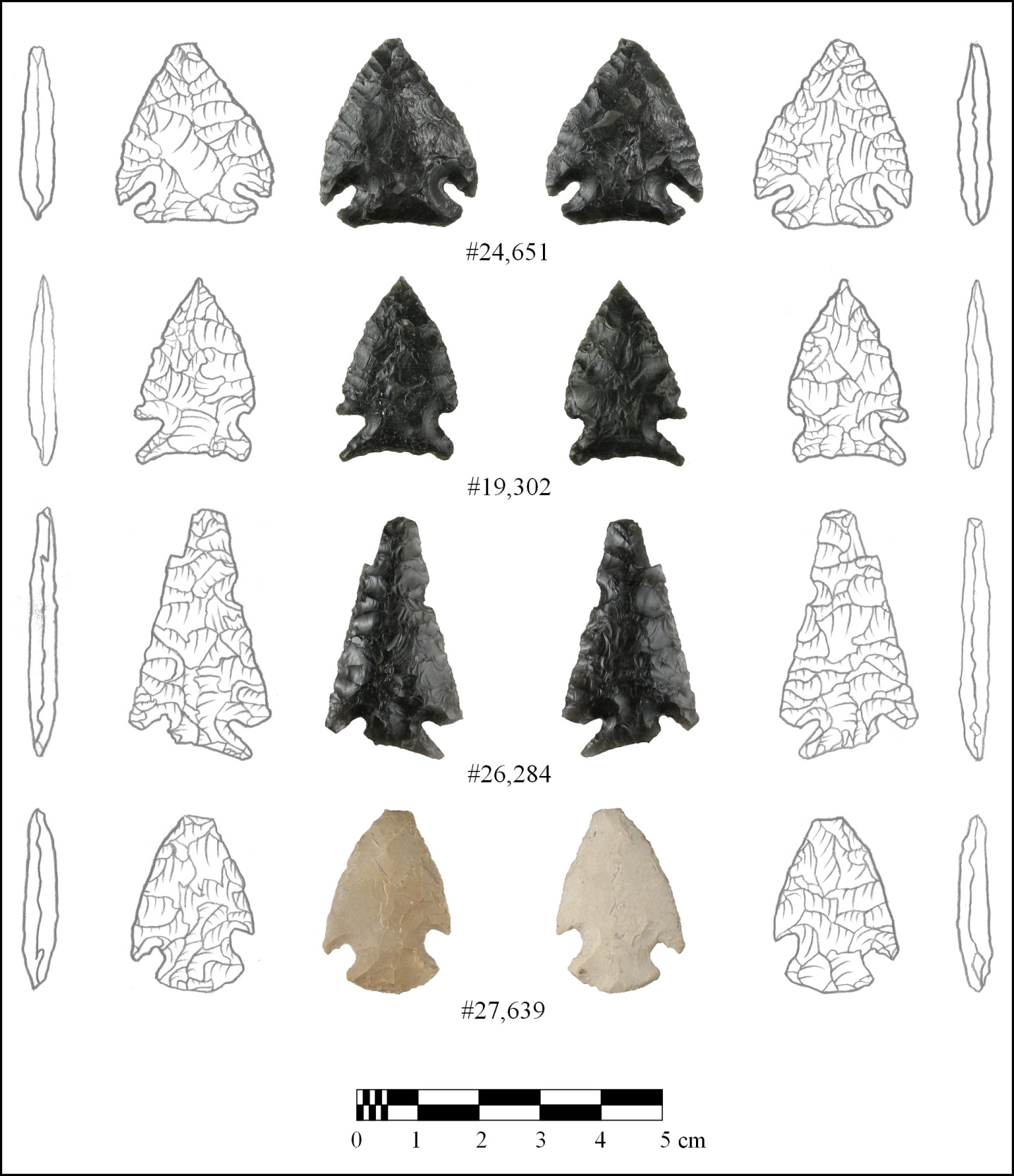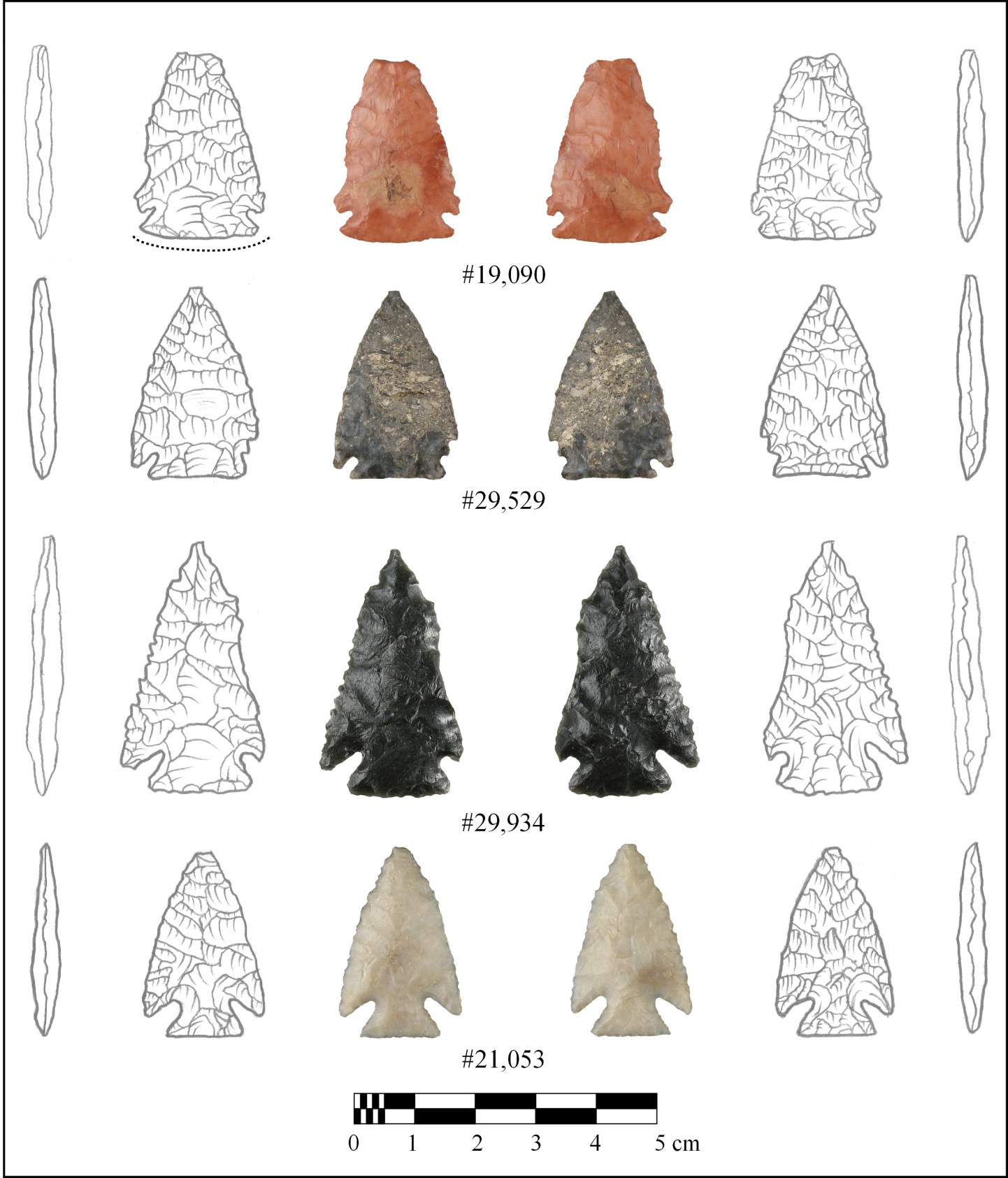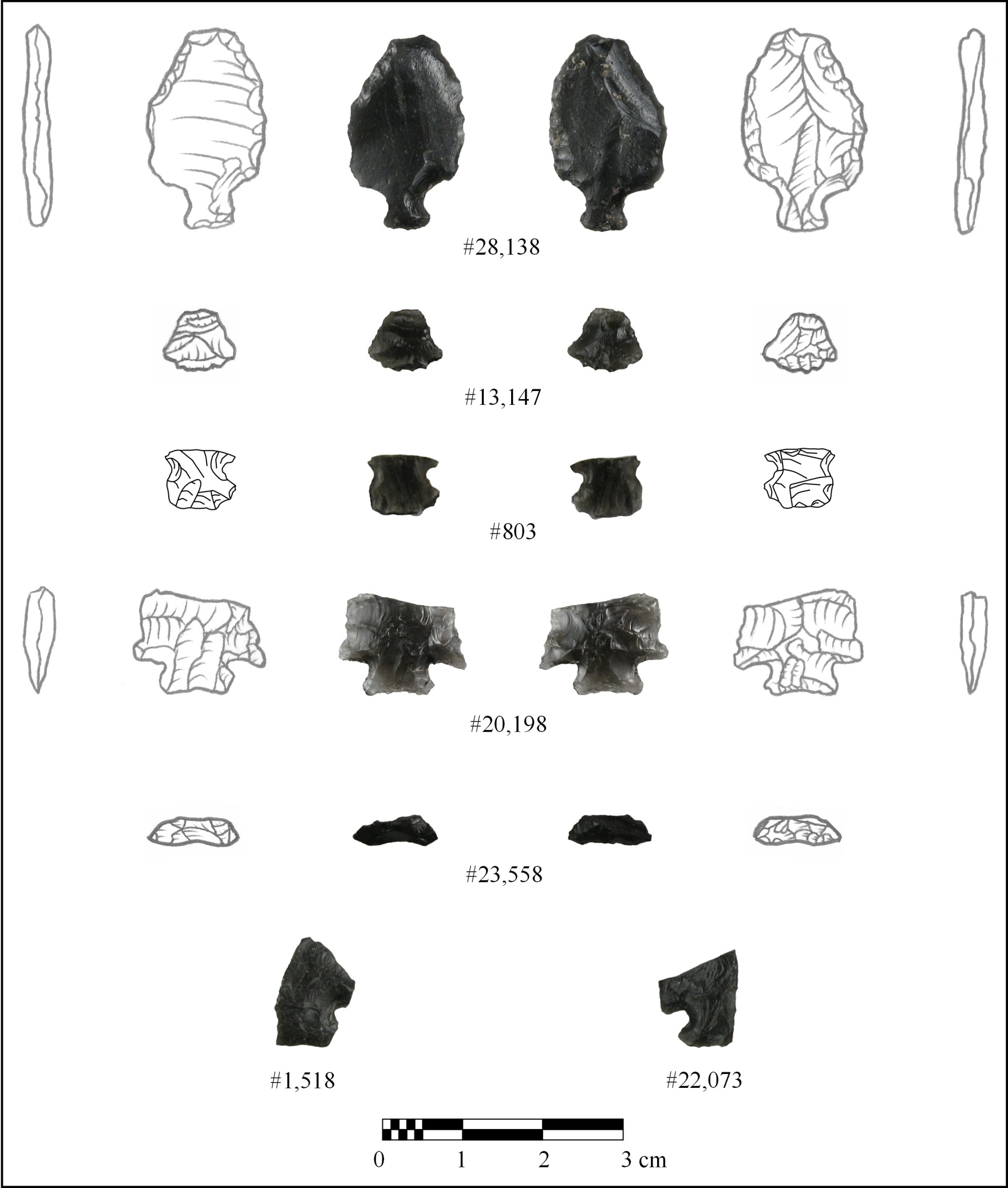-
Home

-
About OWSA

-
Archaeological Survey

- The Game Creek Data Recovery Project
OWSA-Survey recently conducted three seasons of excavations at the Game Creek site (48TE1573) in Jackson Hole, Wyoming. The Game Creek site is a multicomponent open camp with at least 19 dated cultural components spanning much of the last 10,350 years. Excavations produced one of the largest prehistoric archaeological assemblages in the state of Wyoming and shed considerable light on the human prehistory of Jackson Hole and the Greater Yellowstone Ecosystem.
The Game Creek site was first recorded in September 2001 during a class III cultural resource inventory conducted by OWSA-Survey at the request of WYDOT (Eckles and Rosenberg 2002). Initial work at the site consisted of a systematic pedestrian survey and the excavation of six shovel tests. The survey and testing resulted in the recording of 151 pieces of debitage and one Late Paleoindian projectile point. The projectile point was initially identified as a Middle Archaic McKean lanceolate, but the presence of basal margin grinding and beveled resharpening suggest an affiliation with the Pryor Stemmed Complex (Frison 1973; Husted 1969; Pitblado 2003). Eckles and Rosenberg (2002) recommended that the site receive formal evaluative testing in the event of future impacts.
In the summer of 2002 OWSA personnel under the direction of Dan Eakin excavated 18 1-x-1-m test units, 59 shovel tests and five backhoe trenches to assess the presence, extent and integrity of subsurface cultural materials (Eakin and Eckerle 2004). Eakin and Eckerle (2004) identified five sedimentary units on the T3 terrace (Strata I through V). Three radiocarbon dates obtained from charcoal recovered in Stratum III of test units 5, 7 and 10 produced dates of 8690±30 14C BP, 9280±50 14C BP and 9030±30 14C BP, respectively, confirming a Late Paleoindian age for the lower cultural deposits. Charcoal from a fire-cracked rock concentration identified in the wall of trench 1 at approximately 50 cm below the surface in stratum IV was dated to 3860±40 14C BP. No temporally diagnostic artifacts were recovered is situ during testing of the T3 terrace. However, two Late Paleoindian projectile point fragments, a Haskett and a Lovell Constricted, a Late Paleoindian Cody knife and an Archaic Elko Eared/Hanna point fragment were found in disturbed contexts.
In 2010 WYDOT authorized a data recovery project to mitigate adverse impacts to the Game Creek site arising out of the proposed highway expansion. Excavations began in 2010 and concluded in 2012. Approximately 200 square meters of the site was excavated with some blocks reaching depths of two meters. Over 170,000 artifacts were recovered, including 1,164 stone tools and 39,176 faunal remains. The following overview is an excerpt (Page 2016) from the final report of the Game Creek Data Recovery Project.
-
Home

-
About OWSA

-
Archaeological Survey

- The Game Creek Data Recovery Project
OWSA-Survey recently conducted three seasons of excavations at the Game Creek site (48TE1573) in Jackson Hole, Wyoming. The Game Creek site is a multicomponent open camp with at least 19 dated cultural components spanning much of the last 10,350 years. Excavations produced one of the largest prehistoric archaeological assemblages in the state of Wyoming and shed considerable light on the human prehistory of Jackson Hole and the Greater Yellowstone Ecosystem.
The Game Creek site was first recorded in September 2001 during a class III cultural resource inventory conducted by OWSA-Survey at the request of WYDOT (Eckles and Rosenberg 2002). Initial work at the site consisted of a systematic pedestrian survey and the excavation of six shovel tests. The survey and testing resulted in the recording of 151 pieces of debitage and one Late Paleoindian projectile point. The projectile point was initially identified as a Middle Archaic McKean lanceolate, but the presence of basal margin grinding and beveled resharpening suggest an affiliation with the Pryor Stemmed Complex (Frison 1973; Husted 1969; Pitblado 2003). Eckles and Rosenberg (2002) recommended that the site receive formal evaluative testing in the event of future impacts.
In the summer of 2002 OWSA personnel under the direction of Dan Eakin excavated 18 1-x-1-m test units, 59 shovel tests and five backhoe trenches to assess the presence, extent and integrity of subsurface cultural materials (Eakin and Eckerle 2004). Eakin and Eckerle (2004) identified five sedimentary units on the T3 terrace (Strata I through V). Three radiocarbon dates obtained from charcoal recovered in Stratum III of test units 5, 7 and 10 produced dates of 8690±30 14C BP, 9280±50 14C BP and 9030±30 14C BP, respectively, confirming a Late Paleoindian age for the lower cultural deposits. Charcoal from a fire-cracked rock concentration identified in the wall of trench 1 at approximately 50 cm below the surface in stratum IV was dated to 3860±40 14C BP. No temporally diagnostic artifacts were recovered is situ during testing of the T3 terrace. However, two Late Paleoindian projectile point fragments, a Haskett and a Lovell Constricted, a Late Paleoindian Cody knife and an Archaic Elko Eared/Hanna point fragment were found in disturbed contexts.
In 2010 WYDOT authorized a data recovery project to mitigate adverse impacts to the Game Creek site arising out of the proposed highway expansion. Excavations began in 2010 and concluded in 2012. Approximately 200 square meters of the site was excavated with some blocks reaching depths of two meters. Over 170,000 artifacts were recovered, including 1,164 stone tools and 39,176 faunal remains. The following overview is an excerpt (Page 2016) from the final report of the Game Creek Data Recovery Project.
Summary of the Occupational History at Game Creek
The excavations at Game Creek produced evidence for nineteen components, 10 of which are supported by multiple radiocarbon dates, spanning much of the Prehistoric period. Even with high precision AMS dates, the age estimates for these components, calculated at 2 sigma, span 100-400 calibrated years. Consequently, it is likely that multiple components are represented in some of the pooled mean dates. Moreover, it is high probability that some of the components at Game Creek were not sampled or if they were produced few or inadequate datable remains. With these limiting factors taken into consideration, there is solid evidence for intermittent occupation of Game Creek during much of the last 10,400 years.
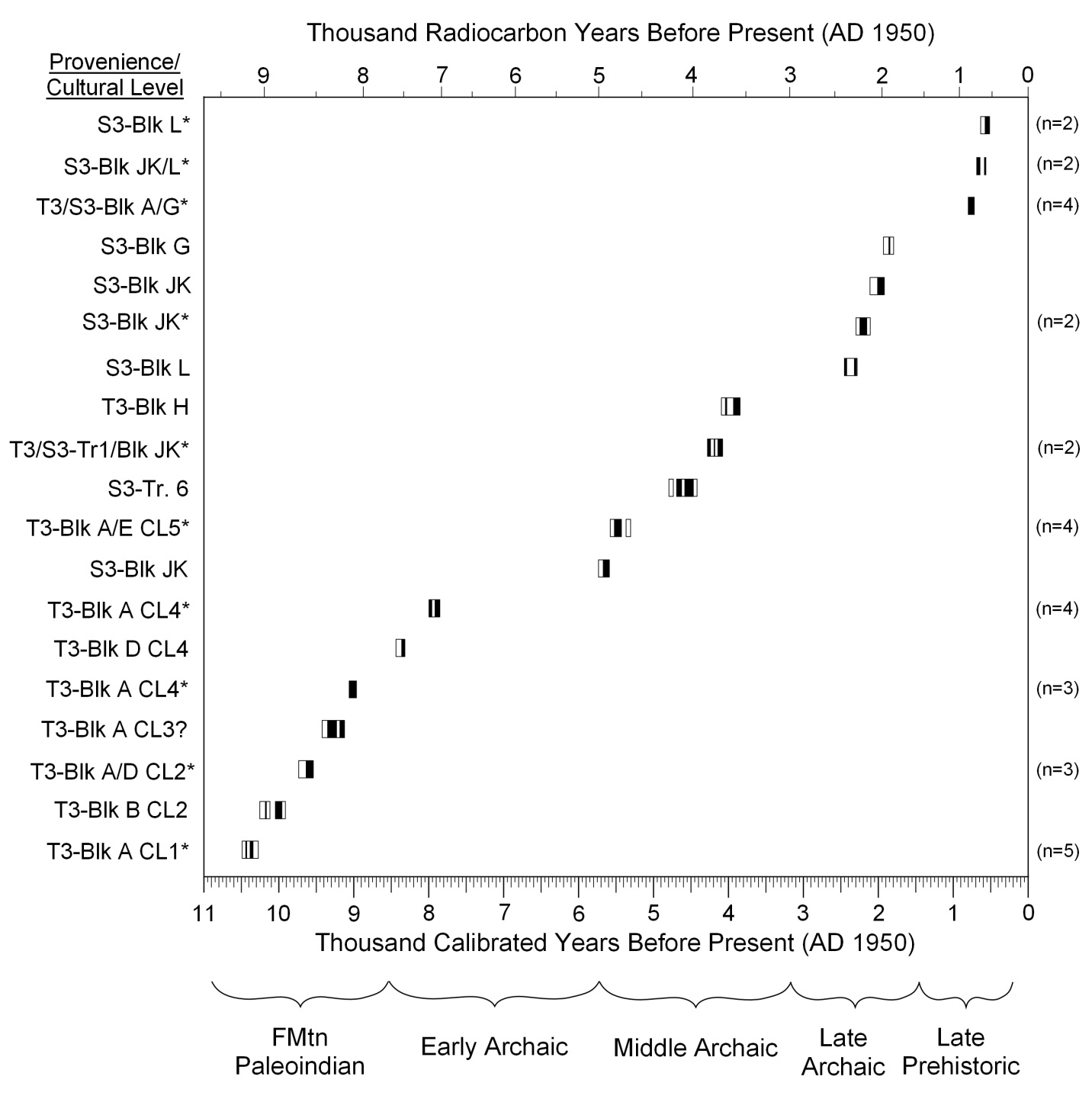
Thousand Calibrated Years Before Present (AD 1950)
Click image to enlarge!
Radiocarbon Dates from the Game Creek (48TE1573) Site, Teton County, Wyoming
Probability block plots of calibrated radiocarbon dates at Game Creek. Plots denoted with an * are pooled mean dates. The number of dates included in the pool is listed at the right of the figure. The bone dates from Cultural Level 4 are excluded. Calibrated at 2s using CALIB 7.0.4, Intcal13 calibration curve (Stuiver and Reimer 1993; Reimer et al. 2013).
|
Radiocarbon Dates from the Game Creek (48TE1573) Site, Teton County, Wyoming |
||||||||
|
Beta # |
LF |
Strat. |
CL |
Material |
Conv. RCYBP |
13C/12C |
M cal BP |
2s Range cal BP |
|
359684 |
S3 |
VIII |
? |
charcoal |
30±30 |
-25.4‰ |
58 |
|
|
359686 |
S3 |
V |
? |
charcoal |
540±30 |
-25.0‰ |
546 |
513-561 [.7], 596-633 [.3] |
|
359683 |
S3 |
IV |
? |
charcoal |
570±30 |
-23.1‰ |
601 |
527-566 [.4], 585-646 [.6] |
|
182051 |
S3 |
? |
? |
charcoal |
650±100 |
-25.0‰ |
619 |
503-766 |
|
341694 |
S3 |
IV |
? |
charcoal |
690±30 |
-24.5‰ |
658 |
563-592 [.28], 638-684 [.72] |
|
359685 |
S3 |
V |
? |
charcoal |
730±30 |
-23.2‰ |
676 |
654-726 |
|
359688 |
S3 |
V |
? |
charcoal |
820±30 |
-25.3‰ |
727 |
684-783 |
|
359689 |
S3 |
VI |
NA |
charcoal |
870±30 |
-24.5‰ |
775 |
698-704 [.01], 706-719 [.02], 721-803 [.73], 808-831 [.06], 855-905 [.18] |
|
359690 |
S3 |
VIII |
7b |
charcoal |
880±30 |
-25.0‰ |
787 |
729-833 [.72], 845-908 [.28] |
|
359682 |
T3 |
V |
7 |
bone |
900±30 |
-19.5‰ |
828 |
740-835 [.54], 840-911 [.46] |
|
359687 |
S3 |
V |
? |
charcoal |
1930±30 |
-23.5‰ |
1878 |
1820-1946 |
|
367728 |
S3 |
IV |
? |
bone |
2070±30 |
-20.9‰ |
2039 |
1949-1962 [.03], 1967-2123 [.97] |
|
341695 |
S3 |
IV |
? |
charcoal |
2150±30 |
-24.0‰ |
2144 |
2008-2021 [.01], 2039-2183 [.67], 2235-2305 [.32] |
|
367729 |
S3 |
IV |
? |
bone |
2190±30 |
-20.0‰ |
2236 |
2128-2310 |
|
367723 |
S3 |
IV |
? |
bone |
2340±30 |
-19.9‰ |
2350 |
2315-2439 [.99], 2450-2455 [.01] |
|
319996 |
T3 |
IV |
4 |
charcoal |
3650±40 |
-25.0‰ |
3970 |
3865-4088 |
|
341692 |
S3 |
III |
? |
charcoal |
3780±30 |
-24.5‰ |
4154 |
4008-4031 [.03], 4082-4244 [.97] |
|
171434 |
T3 |
? |
? |
charcoal |
3860±40 |
-26.6‰ |
4288 |
4155-4,08 [.16], 4218-4413 [.84] |
|
182052 |
S3 |
? |
? |
charcoal |
4080±40 |
-25.4‰ |
4583 |
4438-4488 [.12], 4496-4655 [.63], 4667-4707 [.08], 4756-4811 [.17] |
|
171433 |
T2 |
|
NA |
wood |
4110±40 |
-25.1‰ |
4638 |
4520-4729 [.74], 4750-4821 [.25] |
|
287889 |
T3 |
IV |
5 |
charcoal |
4680±40 |
-22.1 ‰ |
5403 |
5315-5477 [.89], 5537-5577 [.11] |
|
287887 |
T3 |
IV |
5 |
charcoal |
4720±40 |
-23.4 ‰ |
5460 |
5323-5417 [.42], 5442-5489 [.22], 5502-5583 [.36] |
|
|
|
|
5 |
charcoal |
4723±23 |
|
5468 |
5326-5385 [.37], 5447-5486 [.22], 5508-5581 [.41] |
|
321639 |
T3 |
IV |
5 |
bone |
4740±30 |
-19.6‰ |
5511 |
5496-5584 [.57], 5449-5494 [.22], 5329-5379 [.22] |
|
287888 |
T3 |
IV |
5 |
charcoal |
4770±40 |
-23.3 ‰ |
5515 |
5330-5376 [.11], 5456-5592 [.89] |
|
341693 |
S3 |
III |
? |
charcoal |
4960±30 |
-25.3‰ |
5685 |
5608-5742 |
|
315715 |
T3 |
IV |
4 |
bone |
6650±30 |
-19.7‰ |
7531 |
7476-7579 |
|
315714 |
T3 |
IV |
4 |
bone |
6780±30 |
-19.7‰ |
7629 |
7584-7671 |
|
316959 |
T3 |
IV |
4 |
charcoal |
7060±40 |
-23.1‰ |
7892 |
7823-7965 [.98], 7795-7810 [.02] |
|
182053 |
S3 |
III |
? |
charcoal |
7070±40 |
-25.4‰ |
7896 |
7826-7971 [.99] |
|
316960 |
T3 |
IV |
4 |
charcoal |
7150±40 |
-22.8‰ |
7973 |
7928-8028 [.95], 7872-7894 [.05] |
|
319994 |
T3 |
IV |
4 |
charcoal |
7190±40 |
-23.2‰ |
7998 |
7938-8060 [.92], 8089-8111 [.03], 8118-8133 [.02], 8138-8154 [.02] |
|
316955 |
T3 |
IV |
4 |
charcoal |
7580±40 |
-22.8‰ |
8390 |
8336-8444 |
|
319997 |
T3 |
IV |
4 |
tooth |
7860±40 |
-16.6‰ |
8645 |
8546-8778 [.97], 8834-8859 [.02] |
|
287884 |
T3 |
III/II |
1 |
charcoal |
8040±40 |
-24.9 ‰ |
8912 |
8763-9030 [.99] |
|
316957 |
T3 |
III/IV |
4 |
charcoal |
8070±40 |
-23.9‰ |
9002 |
8931-9093 [.74], 8778-8834 [.13], 8859-8923 [.11], 9102-9122 [.02] |
|
316956 |
T3 |
III/IV |
4 |
charcoal |
8120±40 |
-23.0‰ |
9061 |
8992-9137 [.95], 9175-9205 [.03], 9219-9244 [.02] |
|
287886 |
T3 |
III/II |
1 |
charcoal |
8290±40 |
-22.9 ‰ |
9305 |
9190-9427 [.88], 9136-9183 [.12] |
|
171708 |
S1 |
? |
? |
charcoal |
8530±40 |
-26.2‰ |
9517 |
9477-9546 |
|
343147 |
T3 |
III |
2 |
charcoal |
8690±40 |
-23.1‰ |
9631 |
9543-9746 [.99] |
|
171707 |
T3 |
III |
2 |
charcoal |
8690±40 |
-23.2‰ |
9631 |
9543-9746 [.99] |
|
316961 |
T3 |
III |
1 |
charcoal |
8780±40 |
-23.2‰ |
9792 |
9604-9924 [.97], 10,070-10,116 [.03] |
|
171436 |
T3 |
III |
? |
charcoal |
9030±50 |
-22.5‰ |
10,207 |
10,133-10,267 [.92], 9938-9990 [.05] |
|
287885 |
T3 |
III/II |
1 |
charcoal |
9170±40 |
-22.9 ‰ |
10,328 |
10,237-10,429 [.97], 10,464 – 10,482 [.03] |
|
316962 |
T3 |
III/II |
1 |
charcoal |
9180±50 |
-23.3‰ |
10,343 |
10,238-10,440 [.91], 10,453-10,493 [.09] |
|
316958 |
T3 |
III |
2 |
charcoal |
9230±50 |
-21.8‰ |
10,394 |
10,250-10,520 [.99], 10,537-10,546 [.01] |
|
171435 |
T3 |
III |
2 |
charcoal |
9280±50 |
-22.3‰ |
10,463 |
10,277-10,586 |
|
319995 |
T3 |
III |
2 |
charcoal |
9310±50 |
-21.6‰ |
10,513 |
10,371-10,609 [.88], 10,612-10,661 [.07], 10,298-10,330 [.03], 10,339-10,356 [.01] |
|
|
||||||||
Calibrated Radiocarbon Date Frequency Distributions
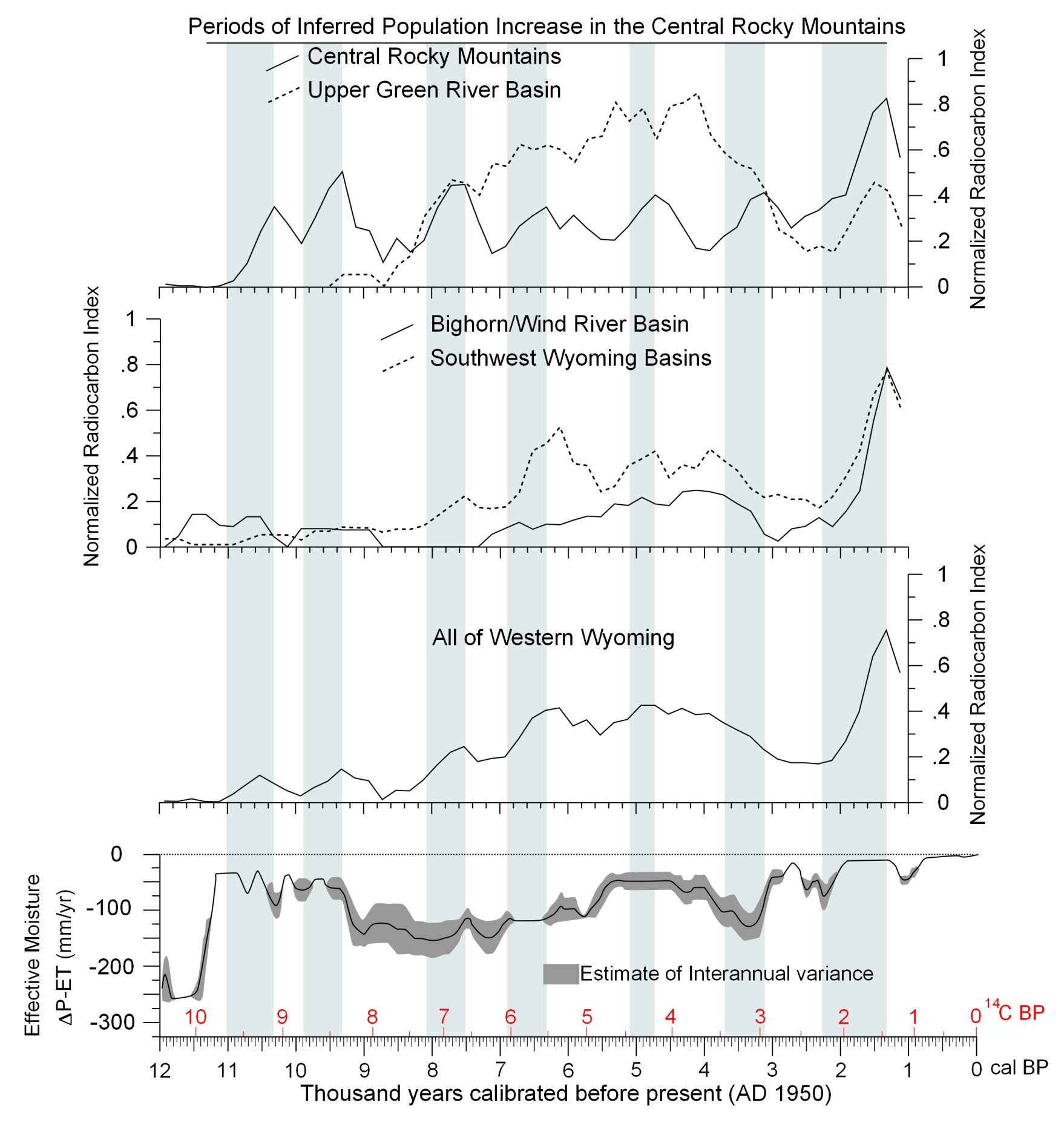
Calibrated Radiocarbon Date Frequency Distributions
Click image to enlarge!
Calibrated radiocarbon date frequency distributions (600-year moving average) for western Wyoming based on sample of 1,307 radiocarbon dates. Calibrated radiocarbon dates have been corrected for taphonomic loss (Kelly et al. 2013; Surovell et al. 2009). Shaded areas highlight periods of inferred human population increase in the Central Rocky Mountains. The lower graph shows historic fluctuations in effective moisture at Lake of the Woods in the Gros Ventre Mountains inferred from paleoshorelines (Shuman et al. 2010).
Cultural Levels 1 and 2
Cultural Levels 1 and 2 contained the bulk of the Late Paleoindian assemblages at Game Creek. The sample of radiocarbon dates from Cultural Level 1 indicates that the initial occupation of the site occurred no later than 10,391±61 cal BP. Most of the evidence for the Cultural Level 1 component was found in the eastern half of Block A and around Block I. There may have been earlier ephemeral occupations associated with a Haskett component west of Block D, but no conclusive data was collected to confirm this. This occupation coincided with an early Holocene peak in human populations in the Central Rockies. The circa 10,300 cal BP peak was immediately followed by a period of population decline. The 10,207±68 cal BP date from TU10 shows that there was another component during the period of decline, but little data was recovered from Block B to elaborate on the nature of that occupation. Populations in the region began to increase again after 9900 cal BP. The three dates from Cultural Level 2, the densest occupation on the T3 terrace, indicate that the site was again occupied around 9660±53 cal BP. The evidence seems to suggest that there were multiple short-term occupations probably occurring over a relatively brief period around Blocks A, D and I. Three features were identified in Cultural Level 1, two of which appear to have simple unlined surface hearths. Spatial analysis of analytical nodules and thermally altered artifacts confirm displayed patterns consistent with hearth-centered use of space. There was some degree of post-depositional mixing that prevented the complete segregation of artifacts between Cultural Levels 1 and 2. Nevertheless, at least one projectile point similar to the unnamed fishtail variety recovered from Mummy Cave Cultural Layer 4 (Husted and Edgar 2002; Larson 2012). Three projectile point fragments were also recovered from Cultural Level 2, two of which conform closely to the Angostura/Ruby Valley type, and the remaining most closely resembles the Birch Creek type. Cultural Levels 1 and 2 produced a small but markedly diverse faunal assemblage containing bison, deer, pronghorn, beaver, porcupine and rabbit. The low diversity of tools and sparse faunal remains suggest that the site served as a hunting camp. The multiple high precision AMS dates from relatively good context make Cultural Levels 1 and 2 some of best dated Late Paleoindian components in the Central Rocky Mountains.
Cultural Level 3 and 4
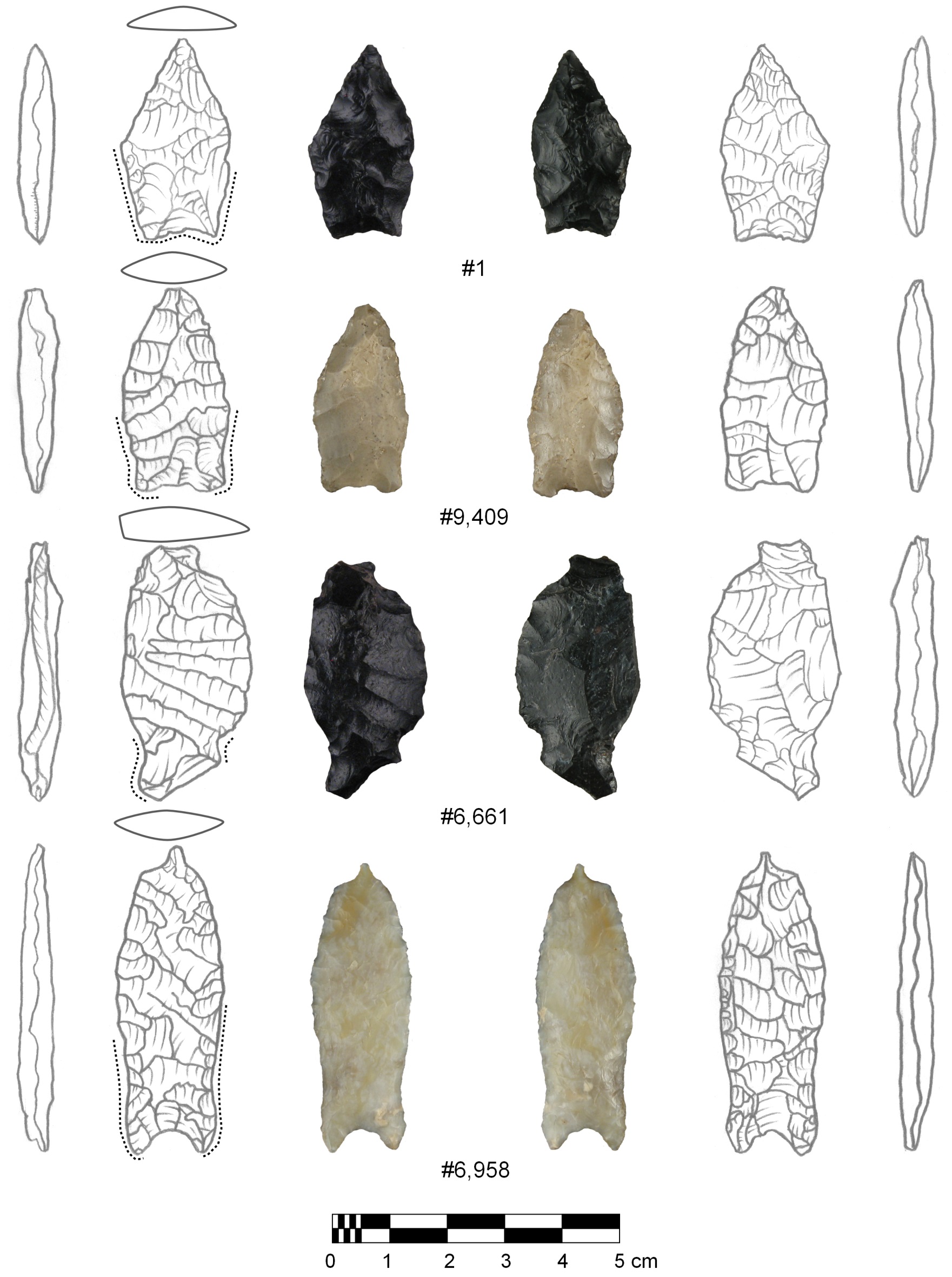
Pryor Stemmed/Lovell Constricted projectile points found at Game Creek.
Click image to enlarge!
The terminal Paleoindian occupation(s) of the site were confined to Cultural Level 3 and 4. The former level produced only a scatter of artifacts and a somewhat unique projectile point that does not closely resemble any named type from the region. There may have been a small ephemeral hearth in Block A, which is a possible source for a 9305±81 cal BP date found about 30 cm below in Cultural Level 1. Bracketing radiocarbon dates place the occupation at sometime between 9650 and 9000 cal BP. There was a concentration of debitage and a few stone tools found within this level in Block I. One of the tools is a bifacial drill that was probably made from a Lovell/Pryor stemmed point (Davis 1990). Given the low frequency of artifacts, dearth of tools and apparent lack of features, it would appear that the T3 terrace at Game Creek served as a short-term hunting camp.
There is evidence for at least three occupations in Cultural Level 4. The earliest, dated to circa 9000 cal BP, produced a small assemblage of Lovell/Pryor stemmed points and a small faunal assemblage that included at least one bison. One small fragment of a metate was also found, but the scarcity of artifacts indicates that the occupation was either an ephemeral hunting camp or perhaps a secondary base camp centered in a part of the site not excavated.
There is a 500 calibrated radiocarbon year hiatus in the occupation of Game Creek following the Lovell/Pryor component in Cultural Level 4. This break in the sequence corresponds to the post-Paleoindian population crash reflected in the radiocarbon date record (Kelly et al. 2013; Surovell et al. 2009). The decline of Foothills-Mountain Paleoindian populations appears to have occurred gradually with steadily decreasing growth rates that coincided with steadily decreasing rates of effective moisture. At around 8750 cal BP the population appears to have completely collapsed.
At around 8400 cal BP Game Creek was again inhabited, probably as a temporary hunting camp. Evidence of this occupation was recovered from Block D and consisted of a fire-cracked rock feature (Feature 8), a concentration of debitage, a few stone tools and a complete projectile point. Although only a small portion of this component was tested, it is the oldest well-dated Early Archaic components identified in all of western Wyoming. Slightly later occupations are documented at the Fishing Bridge (48YE1) site on Yellowstone Lake and four or five sites in the Green River Basin, but Game Creek is the first to produce a diagnostic artifact in firmly dated context. As limited as these data may be, they do shed some light on the temporal parameters of projectile point styles during the initial stages of the Early Archaic.
After a 300-400 year gap in the occupational sequence the T3 terrace was again visited around 8000 cal BP. Most of the artifacts from Cultural Level 4 probably date to this last occupation. Projectile points associated with this Early Archaic component closely resemble the Hanna type of the McKean complex (Frison 1991; Kornfeld et al. 2010) and/or the Elko Eared type of the Great Basin (Justice 2002). Only one side-notched dart, the prototypical Early Archaic point type (Frison 1991; Kornfeld et al. 2010), was recovered from the T3, but it was out of context. The small number of Early Archaic side-notched points from the S3 may be related to the T3 Cultural Level 4 occupations. A radiocarbon date on charcoal collected from 80 cmbs in Trench 6 on the S3 in 2004 is statistically the same as the dates from Block A Cultural Level 4, but none of the side-notched darts were associated with the date and it is unclear from which stratum the charcoal was collected. A sizeable faunal assemblage containing bison, elk and deer was also found in the latest occupation of Cultural Level 4. Although no features were identified there were several diffuse scatters of fire-cracked rock, which suggests that roasting pits or stone boiling features are present on the T3. A mano was also collected from Cultural Level 4 indicating some processing of seeds. The data indicate that the T3 terrace served as a base camp during the latest Cultural Level 4 occupation.
There is a 2100 calibrated year hiatus in occupation at the site following the circa 8000 cal BP occupation in Cultural Level 4. This gap corresponds with most of the Holocene Climatic Optimum. There was a decline in human populations in the Central Rockies between 7500 and 6900 cal BP, followed by an increase between 6900 and 6300 cal BP. There was a corresponding increase in the gravel fraction of slopewash sediment on the T3 at Game Creek that likely reflects decreased vegetation and denudation of the adjacent hillside. It is possible that there were occupations dating to this period at Game Creek, but subsequent migration of the Snake River Channel, perhaps exacerbated by the Devil’s Elbow flood, may have removed these cultural deposits. It is also possible that the decrease in effective moisture between circa 9000 and 5600 cal BP reduced the carrying capacity of southern Jackson Hole making Game Creek a less desirable place to live.
Cultural Level 5 and 6
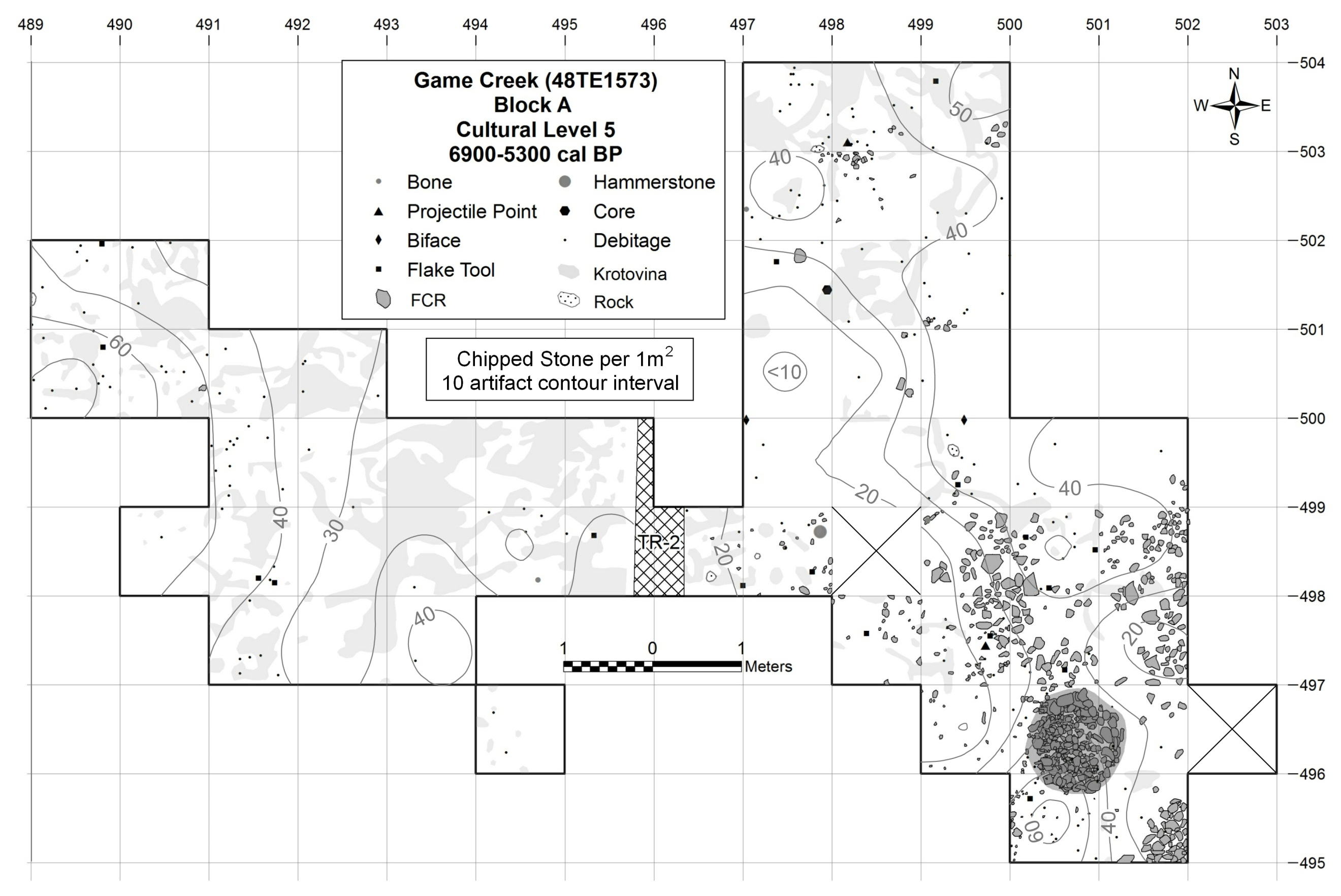
Plan view map of Cultural Level 5 in Block A
Click image to enlarge!
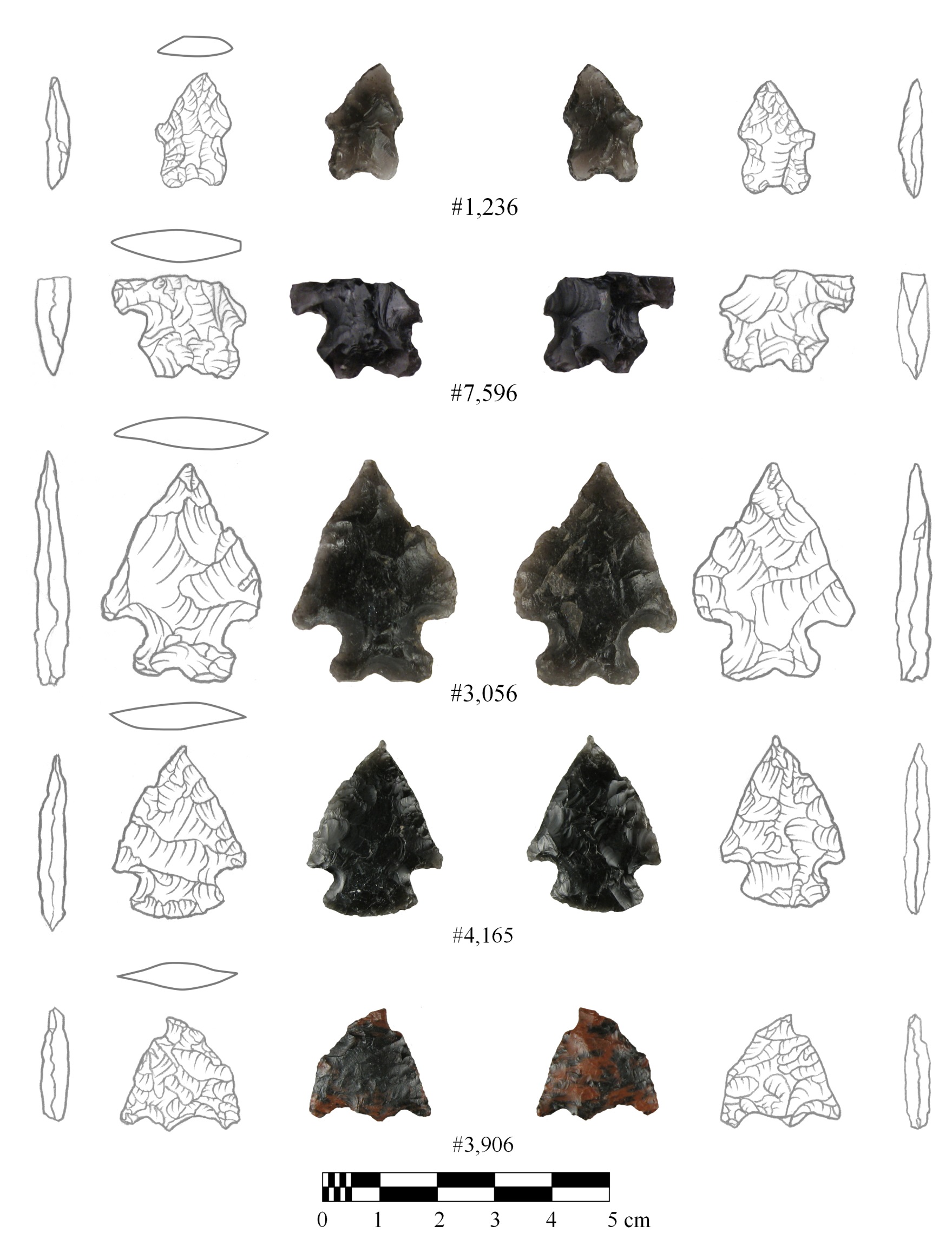
Archaic dart points from Cultural Levels 5 (upper three) and 6 (lower two).
Click image to enlarge!
The next occupation in evidence, Cultural Level 5, produced relatively few artifacts. A large roasting pit (Feature 7) discovered in Block A and a scatter of fire-cracked rock in and around Block E indicates that the landform served as a special use activity area for the processing of roots and tubers. The Cultural Level 5 occupation is dated to about 5520 cal BP. One of the radiocarbon dates from the S3 is just slightly older than the dates from the T3, which may indicate that both landforms were utilized during the Cultural Level 5 occupation. There was a small faunal assemblage that contained bison, elk and beaver bones. Three diagnostic artifacts were recovered and all again closely resemble the Hanna type.
There was another occupational hiatus of approximately 500 years following the Cultural Level 5 component. Again it is possible that this gap is the result of erosional processes because overall this period witnessed a steady increase in human populations in the Central Rockies and adjacent regions associated with the development and spread of the McKean Culture complex.
Cultural Level 6 was very similar to Cultural Level 5 in that it produced a small artifact assemblage and widespread evidence for root and tuber processing. Two roasting pit features (Features 5 and 10) were found in this level, but given their poor state of preservation and lack of associated artifact assemblages neither was dated. It is possible that Feature 1, found during the 2002 testing and dated to 4288±74 cal BP, dates the Cultural Level 6 occupation. One of the dates from the S3 is statistically the same as the date from Feature 1 and may indicate that the S3 served as the residential camp with which the roasting pits were associated. A slightly later date (3970±64 cal BP) was obtained from Block H on the T3. Thus, it is likely that there were multiple occupations at Game Creek during the Middle Archaic period. The small assemblage of stemmed Duncan/Gatecliff and/or McKean Lanceolate points found on the S3 may well have been deposited during these occupations.
The radiocarbon dates indicate that there was a circa 1400 calibrated year break in the occupational sequence between 3850 and 2450 cal BP. There were steady declines in human populations throughout most of western Wyoming during this time. However, the demographic reconstruction of the Central Rockies indicates that unlike the remainder of state there was a dramatic increase in human populations during the first half of the period, circa 3800-3100 cal BP. At least two other sites in Jackson Hole, 48TE1079 and 48TE509 (Lawrence site) have components dated to this time, but most of the sites are in the Yellowstone Plateau. This period of increased population growth coincided with climatic drying trend in the Central Rockies resulting in decreased winter snow accumulation that may have allowed greater hunting opportunities. The lack of an occupation at Game Creek dating to this period is therefore somewhat surprising.
Middle and Late Archaic Period
Between 3100 cal BP and 2700 cal BP populations in the Central Rockies began to decline, which coincided with a return to near modern effective moisture in the region. Populations appear to have rebounded following yet another decline in effective moisture in the region. The inverse correlation between population growth and effective moisture from 3850 to 2000 cal BP in the Central Rockies may reflect emigration from surrounding regions that were adversely impacted by the drying trend. This is essentially the same hypothesis Husted (1969) and Benedict (1981) proffered regarding Early Archaic population shifts during the Holocene Climatic Optimum. Although recent data cast doubt on Husted (1969) and Bendict’s (1981) “Mountain Refugium” hypothesis as it pertains to the Early Archaic (Bender 2016; Kelly et al. 2013; Surovell et al. 2009), the underlying argument may well explain population dynamics during the Middle and Late Archaic periods in western Wyoming.
There was little evidence for occupation of the T3 during the Late Archaic period. However, there are multiple Late Archaic-aged radiocarbon dates and diagnostic artifacts from the S3. The radiocarbon record from the S3 indicates that there were at least four components between 2350 and 1880 cal BP. Corner-notched Pelican Lake/Elko dart points are the most numerous diagnostic artifacts at Game Creek, which suggests that the Late Archaic occupations were intensive as well as redundant. Much of the faunal assemblage from the S3 probably dates to these occupations. The evidence shows a clear focus on the exploitation of high-value big game species, predominantly bison. The two features and numerous concentrations of pulverized faunal remains indicate that bone was intensively processed for marrow and grease, a pattern seen in many sites throughout the Central Rockies (Kornfeld et al. 2010). The remains of one eight month old fetal bison were found on the S3, which indicates a late winter through spring occupation. The poor integrity of the S3 cultural deposit precludes assignment of the fetal remains to a particular component, but three of the four Late Archaic-aged dates correspond with a period of decreased effective moisture that likely resulted in a decrease in snowpack and/or duration of snow cover. Thus, the climate of Jackson Hole during the Late Archaic occupations may have been more amenable to winter habitation than at present. There were also several pieces of groundstone found on the S3 as well as a bone digging stick tip that suggest some degree of plant resource exploitation. Moreover, some of the vast quantity of fire-cracked rock found on the S3 could have been associated with roasting pits and plant processing. If so, then there may have also been spring-summer occupations on the S3 landform as well. The wide range of functional tool types and enormous quantity of debitage and bone recovered from the S3 indicates that the S3 likely served as a primary base camp during the Late Archaic. Then again, it is possible that these artifacts accumulated slowly over thousands of years of ephemeral site use and only mimic the signature of a base camp.
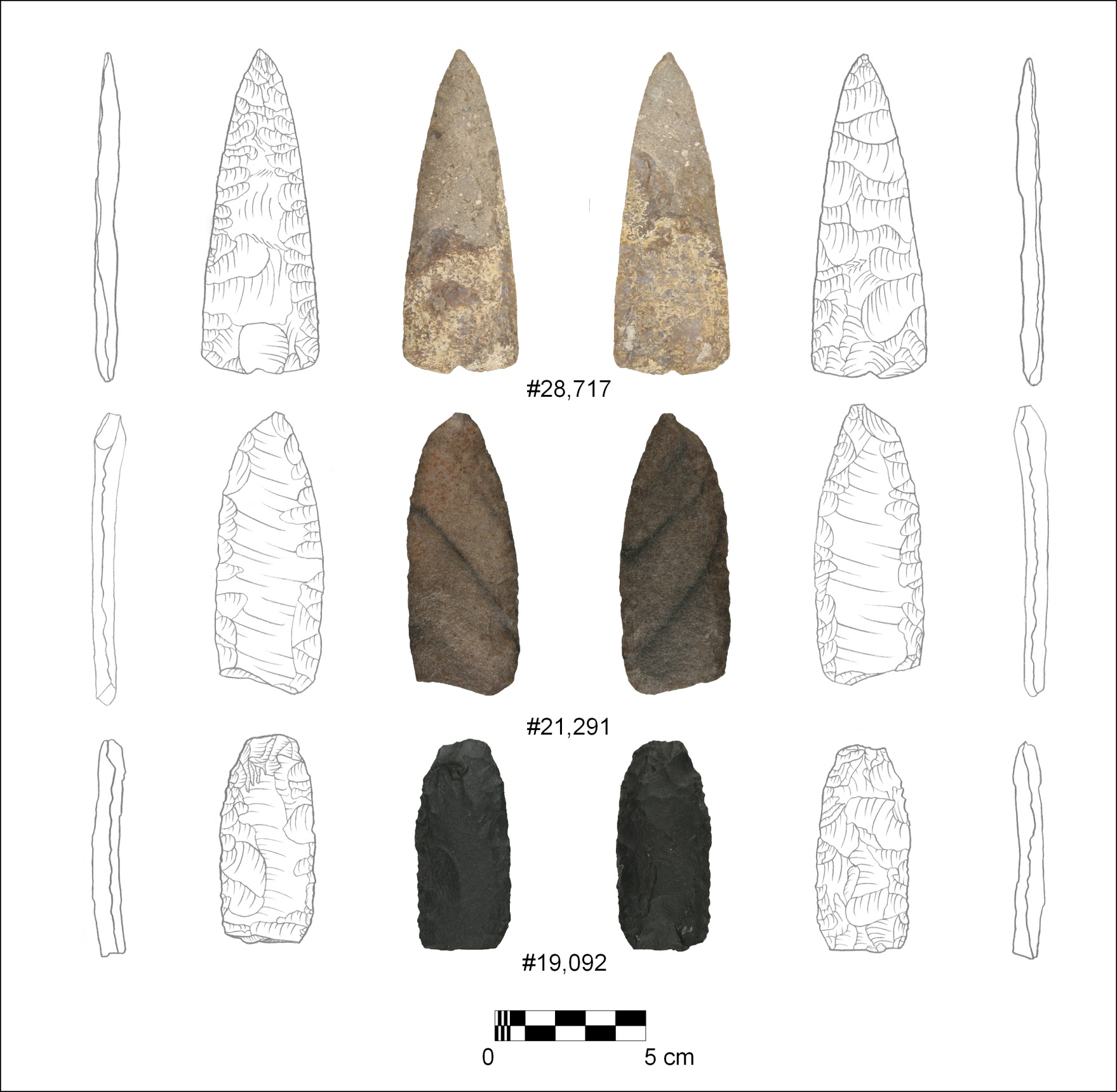
Bifacial knives found on the Game Creek alluvial fan.
Click image to enlarge!
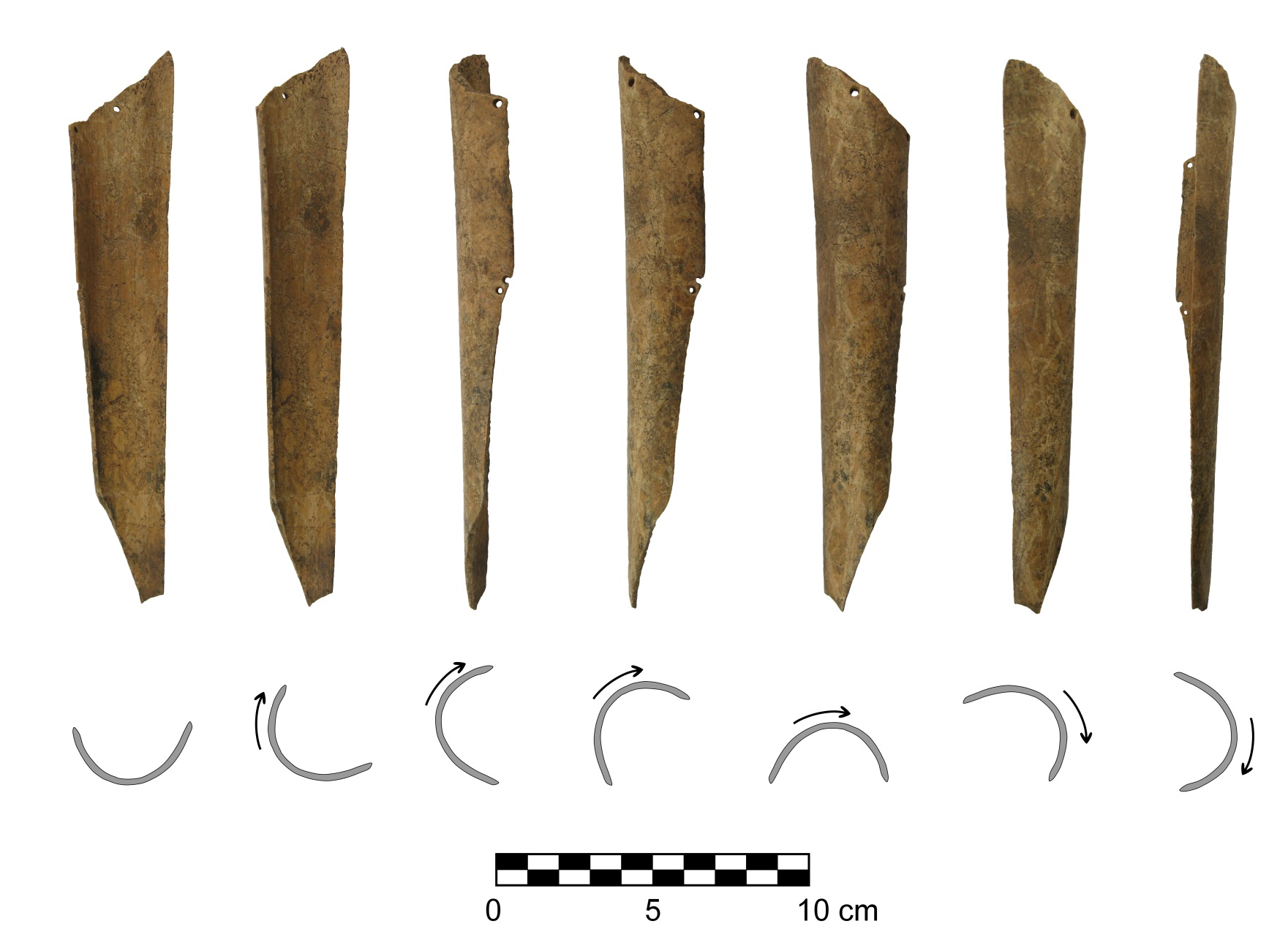
Unique bone tool found on the Game Creek alluvial fan.
Click image to enlarge!
Despite evidence for a mild climate with effective moisture and temperatures near the historic mean, as well as evidence for dramatically increasing human populations throughout western Wyoming, there is no evidence for human occupation at Game Creek from 1800 cal BP to 800 cal BP. There is some indication of a population decline following a circa 1350 cal BP peak, but there has been a well-documented bias against dating Late Prehistoric sites in Archaeology that may very well have influenced the data. Nevertheless, the absence of occupations at Game Creek during this period is somewhat surprising and may well be the result of sampling at the site. There is evidence of a component that may date to this period on the T1 terrace (Eakin and Eckerle 2004), but this area was not included in the data recovery excavations.
Beginning of the Late Prehistoric Period
The beginning of the Late Prehistoric period in the Wyoming is demarcated by the appearance of arrow-sized points and/or pottery, an event somewhat arbitrarily set at circa 1450 cal BP (Kornfeld et al. 2010). The earliest arrow points in the region are loosely affiliated with the Avonlea culture complex. The Wardell site in the upper Green River Basin contained a stratified bison bone bed with hundreds of Avonlea points and produced three standard radiocarbon dates with calibrated ages ranging from 1700 to 692 cal BP several. According to Connor (1998) there have been Avonlea points found in Jackson Hole, but no evidence was recovered from Game Creek. The other early style of arrow point more closely resembles a miniature Pelican Lake dart point and is commonly referred to as the Rose Spring corner-notched type. This style of point appears as early as 1700 cal BP in Idaho, and around 1300 to 900 cal BP at Mummy Cave and continued to be produced until historic contact in some places (Holmer 2009).
Only two Rose Springs points were found on the Game Creek alluvial fan. Unfortunately, the integrity of the deposit precludes a thorough assessment of the component. Yet, the rarity of the point style suggests that the occupations dating to this period were few and or brief and may either be associated with the circa 800 cal BP radiocarbon dates from the T3 terrace and Game Creek alluvial fan or from an undated component perhaps centered on the T1 terrace where another Rose Springs point was recovered in the 2002 testing.
The Final Prehistoric Occupations
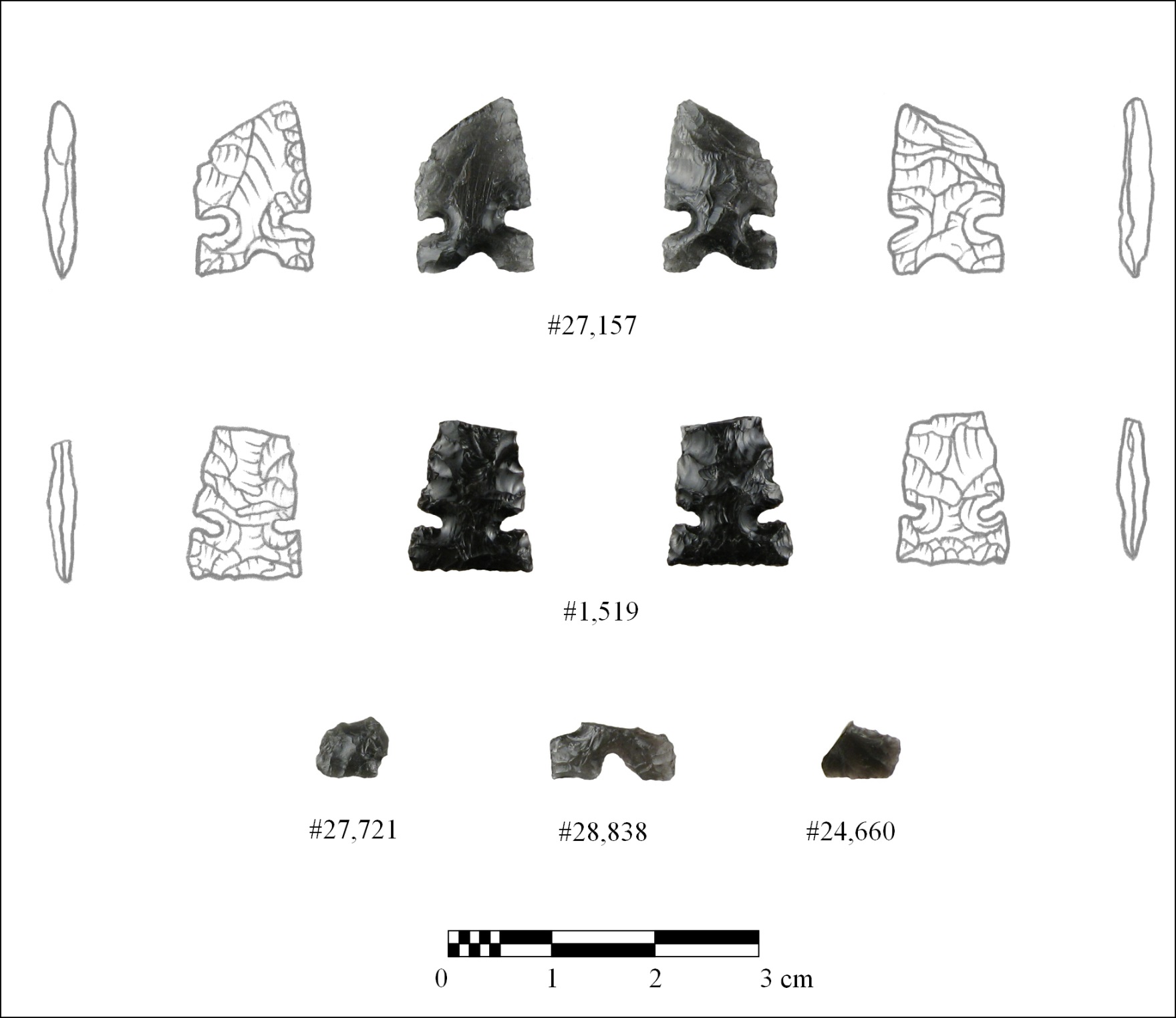
Late Prehistoric Desert side and tri-notched arrow points found on the Game Creek alluvial fan.
Click image to enlarge!
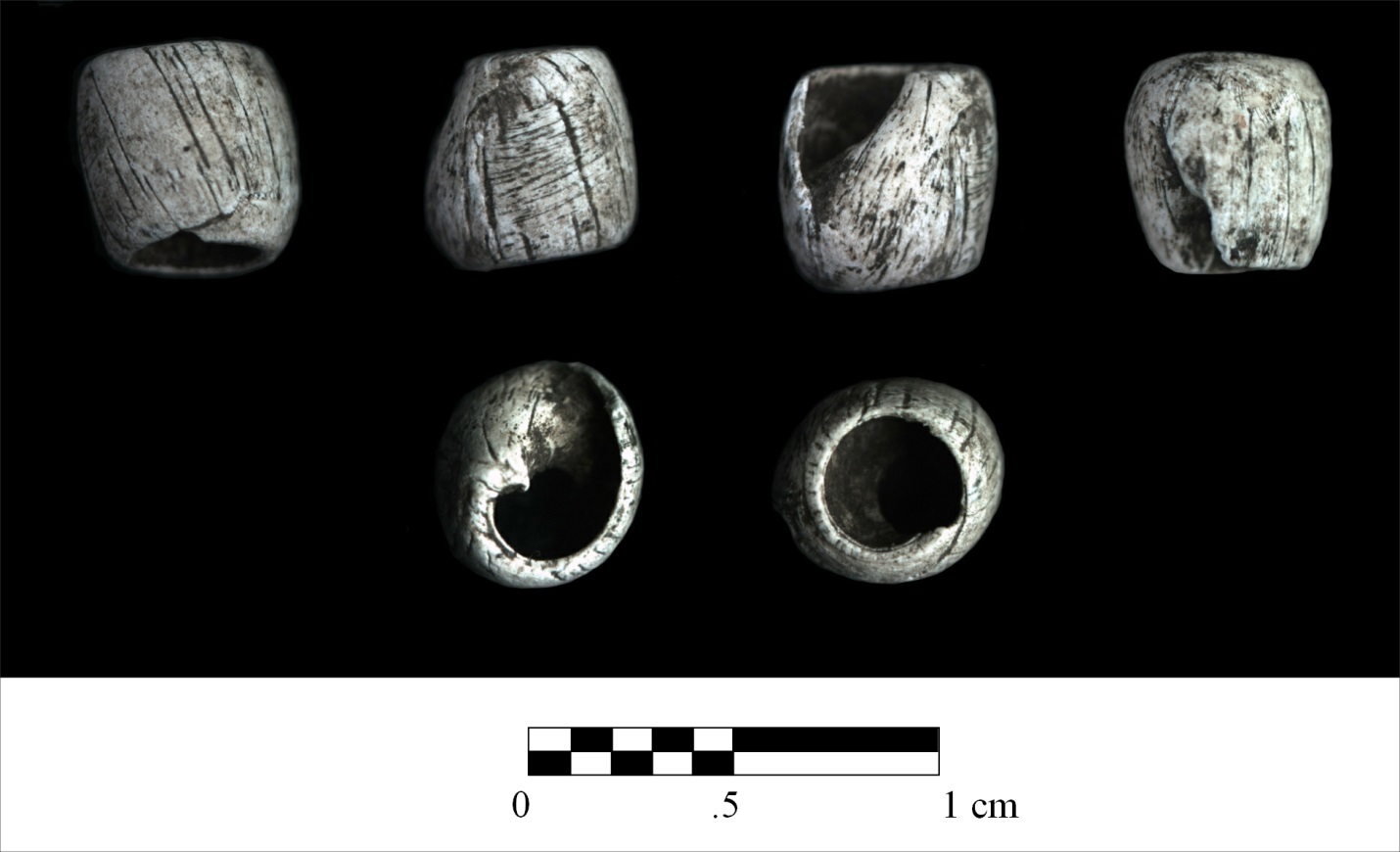
Marine shell bead found in the Late Prehistoric component on the Game Creek alluvial fan.
Click image to enlarge!
The final prehistoric occupations at Game Creek were contained within Cultural Level 7. There was little evidence for occupation on the T3 terrace, but the remains of a bison kill was found on a small remnant of the T2 terrace at the south end of the site. The northern half of Block G on the Game Creek alluvial fan contained most of the artifacts associated with the Late Prehistoric occupation(s). Most of the Cultural Level 7 deposit on the S3 is likely associated the Desert side and tri-notched points found within or immediately above or below the level. There was evidence of a feature that was used in bone grease production. Although no radiocarbon dates are available from Block G Cultural Level 7, two sets of dates from other parts of the S3 provide evidence for occupations at 669±36 cal BP and 554±36 cal BP, either or both of which may date the latest Late Prehistoric occupations that produced the Desert side and tri-notched arrow points.
There was no evidence at Game Creek for human occupation after circa 550 cal BP. This may be explained in part by climate change. With the onset of the Little Ice Age (circa 525-150 cal BP) mean annual temperatures dropped by 1-3° C in the Central Rockies. There is also evidence of decreased spring and summer precipitation that may have been offset by increased winter precipitation. There were also severe droughts in AD 1580 and AD 1717-1718. In addition to the inhospitable climate it was during this period, perhaps as early as the 17th Century that epidemic diseases introduced by Europeans began to spread through Native American populations resulting in catastrophic loss of life (Trimble 1989). Thus, it is not shocking that there was no evidence of occupation at Game Creek after 550 cal BP.
Conclusion
In conclusion, the Game Creek site is the largest stratified archaeological site in Jackson Hole to be thoroughly excavated. In all, 191 m2 of the site was excavated producing over 170,000 artifacts, and 47 AMS radiocarbon dates. The radiocarbon dates and diagnostic artifacts provide evidence for at least 19 cultural components reaching back 10,400 years. These data show that Jackson Hole and adjacent regions share a culture history that is distinct from the Northwestern Plains and perhaps parts of the Central Rockies as well. Moreover, the data, though limited in some respects and instances, enable us to address the subsistence practices and mobility patterns of the people who chose to camp at Game Creek throughout prehistory.
WORKS CITED
Benedict, James B.
1981 The Fourth of July Valley: Glacial Geology and Archeology of the Timberline Ecotone. Research Report No. 2. Center for Mountain Archeology, Ward, Colorado.
Davis, Don P.
1991 Pryor-Stemmed Tools: Twisted Technology on the High Plains. The Wyoming Archaeologist 34(1-2):1-13.
Eakin, Daniel H., and William Eckerle
2004 Archaeological Testing at 48TE1572 and 48TE1573 Hoback Junction - Jackson Snake River section WYDO project NHS-010-4(66) Teton County, Wyoming. Prepared for Wyoming Department of Transportation. Submitted by Office of the Wyoming State Archaeologist Department of State Parks and Cultural Resources. Laramie, Wyoming. Project No. Wy-39-01.
Eckles, David and Robert Rosenberg
2002 A Class III Cultural Resource Survey, Hoback Junction Projects, WYDOT Projects NHS-010-4(6)(65), NHS-010-4(66), NHS-013-3(5), Teton County, Wyoming. Office of the Wyoming State Archaeologist. Submitted to the Wyoming Department of Transportation. Copies available from the Wyoming Cultural Records Office, Laramie.
Frison, George C.
1973 Early Period Marginal Cultural Groups in Northern Wyoming. Plains Anthropologist 18(62):300-312.
1991 Prehistoric Hunters of the High Plains. 2nd edition. Academic Press, San Diego.
Holmer, Richard N.
2009 Field Guide: Projectile Points of Eastern Idaho. Idaho Museum of Natural History, Idaho State University, Pocatello.
Husted, Wilfred M.
1969 Bighorn Canyon Archeology. Publications in Salvage Archeology, No. 12. River Basin Surveys, Smithsonian Institution, Lincoln.
Husted, Wilfred M. And Robert Edgar
2002 The Archeology of Mummy Cave, Wyoming: An Introduction to Shoshonean Prehistory. Special Report No. 4, Midwest Archeological Center and Technical Reports Series No. 9, Southeast Archeological Center. United States Department of the Interior, National Park Service, Midwest Archeological Center, Lincoln, Nebraska.
Kelly, Robert L., Todd A. Surovell, Bryan N. Shuman, and Geoffrey M. Smith
2013 A Continuous Climatic Impact on Holocene Population in the Rocky Mountains. Proceedings of the National Academy of Sciences 110 :443-447.
Kornfeld, Marcel, George C. Frison, and Mary Lou Larson
2010 Prehistoric Hunter-Gatherers of the High Plains and Rockies. 3rd ed. Left Coast Press, Walnut Creek, California.
Larson, Mary Lou
2012 The Paleoindian to Archaic Transition: The Northwestern Plains and Central Rocky Mountains. In From the Pleistocene to the Holocene: Human Organization and Cultural Transformation in Prehistoric North America., edited by Britt C. Bousman and Bradley J. Vierra, pp. 149-169. Texas A & M University Anthropology Series No. 17. College Station, TX.
Shuman, Bryan, Paul Pribly, Thomas A. Minckley, and Jacqueline J. Shinker
2010 Rapid Hydrologic Shifts and Prolonged Droughts in Rocky Mountain Headwaters during the Pleistocene. Geophysical Research Letters 37, L06701.
Surovell, Todd A., Judson Byrd Finley, Geoffrey M. Smith, P. Jeffrey Brantingham and Robert Kelly
2009 Correcting temporal frequency distributions for taphonomic bias. Journal of Archaeological Science 36:1715-1724.
Trimble, Michael K.
1989 Infectious Disease and the Northern Plains Horticulturalists: A Human Behavior Model. Plains Anthropologist Memoir 23, Pt. 2, 34(124):41-59.


